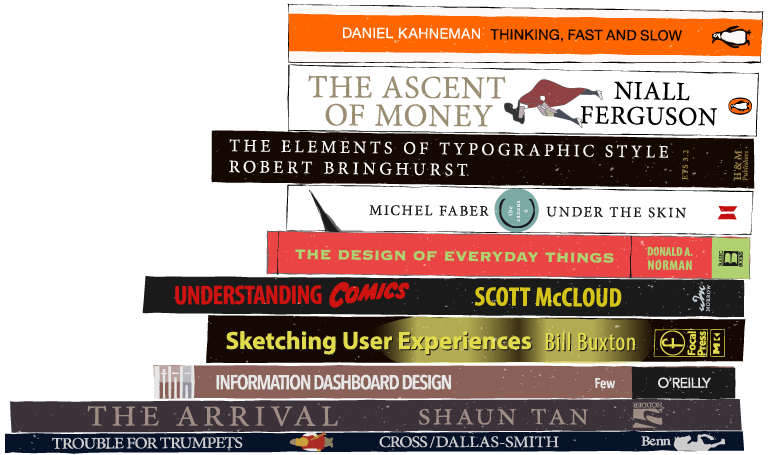I am often asked for recommended reading on design by people from all sorts of different backgrounds. My answers vary wildly depending on the person asking and the angle or topic I think might be most relevant to them. However, there are certain books that come up quite often so here are a rounded collection of recommendations. It may surprise some that only a handful of these books are actually about design but I strongly believe that you can learn as much, if not more, from outside the world of design. After all, analysing, understanding and repurposing are some of the most powerful skills for designers to hone.
Note: I greatly favour proper books over e-books. All of the following recommendations are better in physical form: you are presented with what the creators wanted to put in front of you, and you can annotate, dog-ear or “customise” them in any way you see fit because they are actually yours.
In no particular order:

Thinking, Fast and Slow by Daniel Kahneman
Daniel Kahneman is a Nobel-prize winning cognitive psychologist who has done extensive work on the psychology of judgement and decision-making. Thinking, Fast and Slow presents numerous insights into how humans think by summarising much of the research he has conducted. As designers creating systems for humans, there is no more valuable understanding than that of our own thinking processes.
The Ascent of Money by Niall Ferguson
This book is representative of how all knowledge domains are most effectively understood by rolling them back to the fundamentals. A strong grasp of the foundations of a domain provides the necessary insights to meaningfully question and understand anything that follows on from those basic building blocks. Few sectors have built upon and twisted their origins as financial services, but by taking you through the journey from the beginning of money to our modern financial system it starts to become more comprehensible. In my experience, this technique allows you to quickly get your head around even the most esoteric of subjects.
The Elements of Typographic Style by Robert Bringhurst
Words, letters and numbers are undoubtedly the most common and effective concrete means of communicating information. Typography is the art of designing the presentation of those words, letters and numbers, so its relevance to designers should be self-evident. Although other books and articles originally piqued my interest in typography, this book is quite simply the typography bible. Robert Bringhurst manages to bring what can be a quite dry subject to life through both the writing itself and the application of what he teaches to the material.
Under The Skin by Michel Faber
Under The Skin unnerved me in a way few other experiences have, not because of its plot as such, but through its use of language. It highlights the inherent, subconscious assumptions we all work under and how easily small infractions of those assumptions significantly undermine our understanding. Designers must always be conscious of any assumptions they are working under and should seek to challenge and question them whenever possible.
The Design of Everyday Things by Donald Norman
Ask any designer for recommended reading and this book is very likely to come up, for good reasons! Don Norman expertly introduces the importance of good design to all products and deftly explains the fundamental design concept of ‘affordances’ – not ‘contextual cues’ as I called them when sort of discovering this for myself, d’oh! If that wasn’t enough, after reading the book, you will never look at a door the same way again.
Understanding Comics by Scott McCloud
In Understanding Comics, Scott McCloud uses a comic to dissect, analyse and explain comics as a storytelling medium. This way, McCloud ably demonstrates that comics are not the childish medium many dismiss them to be. Rather, he shows that playfulness can be an exceedingly effective way to explore serious concepts – something that is all too often forgotten in our professional lives! Furthermore, all his insights on reductionism and storytelling in comics are both directly applicable to design work such as storyboards and indirectly applicable as concepts to all aspects of design.
Sketching User Experiences by Bill Buxton
Sketching User Experiences should be the first stop for anyone involved with creating products or systems. In it, Bill Buxton explores the notion of design thinking and its holistic impact on your approach to problem solving. Buxton brings his work and thoughts to life by grounding them in both practice and scientific research, leaving you with both inspiration and immediately applicable techniques for your next project.
Information Dashboard Design by Stephen Few
After Edward Tufte’s work initially brought the world of data visualisation to my attention, it was through Stephen Few that my interest and understanding blossomed and solidified. All 4 of his books are worth reading but Information Dashboard Design is the ideal starting point as it deftly covers the design of individual visualisations as well as how they can be combined to create a powerful whole. By explaining the seemingly obvious but rarely consciously considered, Few provides genuine understanding of the topic for you to build on and with rather than prescribing any particular approach or rights and wrongs.
The Arrival by Shaun Tan
The Arrival is a wordless migrant story of such beauty that it can’t fail to leave an impression on you. Its illustrations use a mixture of the mundane and the fantastical to bring remarkably detailed and complex human emotions to life. Shaun Tan’s pencil work is an inspiration in itself, but the bigger lesson to me is the sheer power of purely visual communication when used appropriately.
Trouble For Trumpets by Peter Cross and Peter Dallas-Smith
I spent so many hours pouring over Trouble For Trumpets’ illustrations as a child that I had to buy a new copy (not a straightforward task, given its fairly limited print) as a teenager due to the original falling to pieces. What makes this book stand out is its incredible attention to detail. An entire universe is communicated down to the tiniest minutiae in a mere 32 pages without ever distracting from the story. Every illustration contains dozens of mini-stories and many are annotated to call out the names of characters, plants, weapons and other details. As a designer, it reminds me that no matter how mundane a project might initially seem, putting your soul into it and paying attention to every little detail will elevate it to something special.



